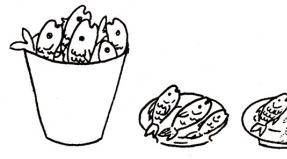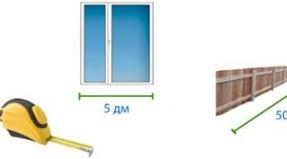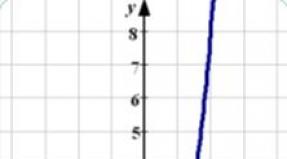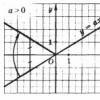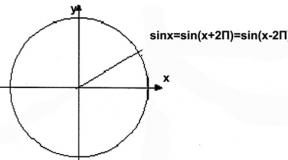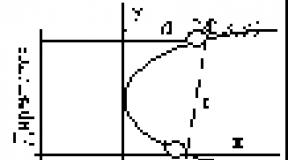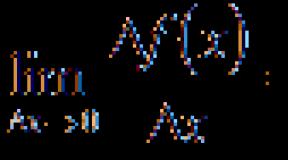What is the perimeter formula. What is a perimeter and how do I find it? What have we learned
Surely each of us taught at school such an important component of geometry as the perimeter. Finding the perimeter is essential for many tasks. Our article will tell you how to find the perimeter.
It is worth remembering that the perimeter of any figure is almost always the sum of its sides. Let's take a look at a few different geometric shapes.
- A rectangle is a quadrangle in which the parallel sides are equal in pairs. If one side is X and the other is Y, then we get the following formula for finding the perimeter of this figure:
P \u003d 2 (X + Y) \u003d X + Y + X + Y \u003d 2X + 2Y.
An example of solving the problem:
Let's assume that side X \u003d 5 cm, side Y \u003d 10 cm. So, substituting these values \u200b\u200binto our formula, we get - P \u003d 2 * 5 cm + 2 * 10 cm \u003d 30 cm.
- A trapezoid is a quadrilateral in which two opposite sides are parallel, but not equal to each other. The perimeter of a trapezoid is the sum of all four of its sides:
P \u003d X + Y + Z + W, where X, Y, Z, W are the sides of the figure.
An example of solving the problem:
Let's say that side X \u003d 5 cm, side Y \u003d 10 cm, side Z \u003d 8 cm, side W \u003d 20 cm.That means, substituting these values \u200b\u200binto our formula, we get - P \u003d 5 cm + 10 cm + 8 cm + 20 cm \u003d 43 cm.
- The perimeter of a circle (circumference) can be calculated using the formula:
P \u003d 2rπ \u003d dπ, where r is the radius of the circle, d is the diameter of the circle.
An example of solving the problem:
Suppose that the radius r of our circle is 5 cm, then the diameter d will be 2 * 5 cm \u003d 10 cm. It is known that π \u003d 3.14. So, substituting these values \u200b\u200binto our formula, we get - P \u003d 2 * 5 cm * 3.14 \u003d 31.4 cm.
- If you need to find the perimeter of a triangle, then you can face a number of problems with this, since triangles can have very different shapes. For example, there are sharp, obtuse, isosceles, right-angled, or equilateral triangles. Although the formula for all types of triangles is:
P \u003d X + Y + Z, where X, Y, Z are the sides of the figure.
The problem is that when solving many problems of finding the perimeter of this figure, you will not always know the lengths of all sides. For example, instead of information about the length of one of the sides, you can have the degree of the angle or the length of the height of a particular triangle. This will significantly complicate the task, but will not make it unrealistic. How to find the perimeter of a triangle, whatever shape it may be, you can read "".
- The perimeter of a figure such as a rhombus is found in the same way as the perimeter of a square, because a rhombus is a parallelogram that has equal sides. You can find out how to find the perimeter of a square by reading the article on our website "".
Now you know how to find the side of the perimeter of the geometric shape that you need!
The perimeter is the sum of the lengths of all sides, for example, a rectangle, a square. To find it, you need to add all the sides. And if we have a square, then we need to multiply one side by 4.
For instance.
rectangle:
width 5 cm
length 8 cm
5+5+8+8=26
square:
width and length 3 cm
3 times 4 \u003d 12cm
The perimeter is the sum of the lengths of all sides of a geometric figure, denoted by the letter P, some formulas for finding the perimeter
triangle
P \u003d a + b + c
rectangle
P \u003d 2 * (a + b)
square
P \u003d 4 * a
Similar tasks:
1) find the sum of the angles of a convex twelve gon, each angle of a convex polygon \u003d 135 * Find the number of sides of this polygon.
2) In a convex pentagon, 2 sides are equal, 3 side is 3cm larger, and 4 is 2 times larger than 1 side, and the 5th side is 4cm less than 4cm. Find the sides of the pentagon if it is known that the perimeter \u003d 34cm
1) Two pumps working together fill the pool in 4 hours. The first pump fills the pool one and a half times faster than the second. How many hours does the first pump take to fill the pool?
2) The perimeter of the parallelogram is 90 cm and the acute angle is 60 °. The diagonal of a parallelogram divides its obtuse angle into parts in a ratio of 1: 3. Find the length of the longer side of the parallelogram.
3) The second term of the arithmetic progression is 5, and its fourth term is 11. Find the sum of the first five terms of the progression.
4) The area of \u200b\u200bthe parallelogram is 〖24cm〗 ^ 2. The point of intersection of its diagonals is 2 cm and 3 cm away from the straight lines on which the sides lie. Find the perimeter of the parallelogram.
In the following test tasks, you need to find the perimeter of the figure shown in the figure.
You can find the perimeter of a shape in different ways. You can transform the original shape so that the perimeter of the new shape can be easily calculated (for example, go to a rectangle).
Another solution is to look for the perimeter of the figure directly (as the sum of the lengths of all its sides). But in this case, you cannot rely only on the drawing, but find the lengths of the segments based on the data of the problem.
I want to warn you: in one of the tasks among the proposed answers, I did not find the one that I got.
C) .

Move the sides of the small rectangles from the inside to the outside. As a result, the large rectangle is closed. Formula for finding the perimeter of a rectangle
In this case, a \u003d 9a, b \u003d 3a + a \u003d 4a. So P \u003d 2 (9a + 4a) \u003d 26a. To the perimeter of the large rectangle, add the sum of the lengths of four segments, each of which is equal to 3a. As a result, P \u003d 26a + 4 ∙ 3a \u003d 38a .

C) .
After transferring the inner sides of the small rectangles to the outer area, we get a large rectangle, the perimeter of which is P \u003d 2 (10x + 6x) \u003d 32x, and four segments, two are x-long, two are 2x-long.
Total, P \u003d 32x + 2 ∙ 2x + 2 ∙ x \u003d 38x .


?) .

Let's transfer 6 horizontal "steps" from the inside to the outside. The perimeter of the resulting large rectangle is P \u003d 2 (6y + 8y) \u003d 28y. It remains to find the sum of the lengths of the segments inside the rectangle 4y + 6 ∙ y \u003d 10y. Thus, the perimeter of the figure is P \u003d 28y + 10y \u003d 38y .

D) .

Move the vertical segments from the inner region of the shape to the left, to the outer region. To get a large rectangle, move one of the 4x lengths to the bottom left corner.
We find the perimeter of the original figure as the sum of the perimeter of this large rectangle and the lengths of the remaining three segments P \u003d 2 (10x + 8x) + 6x + 4x + 2x \u003d 48x .

E) .

Moving the inner sides of the small rectangles to the outer area, we get a large square. Its perimeter is P \u003d 4 ∙ 10x \u003d 40x. To get the perimeter of the original shape, add the sum of the lengths of eight segments, each 3x long, at the perimeter of the square. Total, P \u003d 40x + 8 ∙ 3x \u003d 64x .

B) .

Move all horizontal "steps" and vertical top segments to the outer area. The perimeter of the resulting rectangle is P \u003d 2 (7y + 4y) \u003d 22y. To find the perimeter of the original figure, add the sum of the lengths of four segments, each of length y, to the perimeter of the rectangle: P \u003d 22y + 4 ∙ y \u003d 26y .

D) .

Let's transfer all horizontal lines from the inner region to the outer one and move the two vertical outer lines in the left and right corners, respectively, by z to the left and to the right. As a result, we get a large rectangle, the perimeter of which is P \u003d 2 (11z + 3z) \u003d 28z.
The perimeter of the original figure is equal to the sum of the perimeter of the large rectangle and the lengths of six segments along z: P \u003d 28z + 6 ∙ z \u003d 34z .

B) .

The solution is completely similar to the solution in the previous example. After transforming the shape, we find the perimeter of the large rectangle:
P \u003d 2 (5z + 3z) \u003d 16z. To the perimeter of the rectangle we add the sum of the lengths of the remaining six segments, each of which is equal to z: P \u003d 16z + 6 ∙ z \u003d 22z .
Development of an extra-curricular lesson in arithmetic in grade 2 on the topic: Perimeter of a triangle and a square
Extracurricular lesson in arithmetic 2nd grade.
How to find the perimeter of a rectangle.
Topic: Perimeter of a triangle and a square.
1. Introduce the concept of the perimeter of a triangle and a square. 2. Learn to use formulas in practice triangle and a square. 3. Development of logical thinking, speech.
Equipment: clarity Triangle, split triangles, 12 fragments of figures, 2 triangles, perimeter formulas.
Literature: In the country of amusing figures, Geometric construction of 2 classes.
II. Exercise for attention.
Take a close look at the shapes and remember how the points are placed.
For now, I'll close the board, and you remember, try to draw the placement on your own pieces of paper.
Let's check. Raise your hand who hasn't made a single mistake. Well done! Who made mistakes, be careful.
III. Researching new material.
And now we will go to the delightful country of Geometry. And who to visit, you have to guess. Listen to the poem Triangle and Square.
There lived two brothers: Triangle with Square. Senior - Square, Benevolent, pleasant. The youngest - triangular - Always dissatisfied. He began to ask the Square: Why are you angry, brother? He yells to him: -Look: You are fuller and more extensive than me. I only have three corners, you have four! But the square answered: -Brother! I'm older, I'm a Square! I, - said even more tenderly: - It is not known who is needed! But night was set, and to my brother; Bumping into tables, The younger climbs stealthily, Cut off the older corners. Leaving, he said: - I wish you pleasant dreams! I went to bed - I was square, And you wake up without corners. But the next morning, the younger brother of Terrible Vengeance was not happy.
Guys, let's see why the younger brother of terrible revenge was not happy. Who will go to the board and cut the corners of the square?
He looked - there is no Square Numb ... stood without words ... Is that revenge? Now Brother Has Eight New Corners!
What's up with the square?
So where are we going to travel?
True, the city of triangles and squares. And Triangle will accompany us. But she will accompany us in this case, if we answer the questions.
1. What is the difference between a triangle and a square?
2. What is remarkable about the square?
Well done! You can set off on a journey.
So we arrived in the city of Triangles and Squares and a new task awaits us.
Assignment 1: Can You Behold?
How many triangles are hidden in this house? (5) What about quadrangles? (1)
Task 2: There are 9 triangles in the drawing. Will you be able to see them? Who will go and show?
Assignment 3: Look at the figure. How many quadrangles? (7) How many squares are there? (3)
Practical task Who is faster
What is called a perimeter triangle?
Means what we have to do to find the perimeter? (1. measure the length of the sides; 2. find their sum).
This is how the formula for the perimeter of triangles looks like: P \u003d a in s.
Using this formula, you can find the sum of the lengths of the sides of any triangle.
The sum of the lengths of the sides of a triangle is called ...
Well done! Draw a square, knowing only the length of one side, and find the sum of the lengths of its sides. The side of the square is 4 cm. Can we draw a square knowing only one side? Why?
Guys, what do you think is the sum of the side lengths of a square?
That's right, the amount side lengths square - perimeter. Let's deduce a formula by which we can find the perimeter square with side a. Who will try?
Knowing that four times a day means what can we do?
Yes, we can replace addition by multiplication, then we get the formula P \u003d 4a. For a nice notation, the number 4 is put first, and then the letter. In practice, this formula is used.
What did we do with you now?
What is called a perimeter?
What does the formula for the perimeter of a triangle sound like?
Read the formula for the perimeter of a square?
IV. Consolidation of the passed material.
1) Draw a square according to the given perimeters: in-1 -8cm, in-2 - 12cm. 2) Given a triangle. Find its perimeter. 3) For the holiday, students decorate the outside of the school building from all quadrangular sides with flags. There are not many flags, only 12. How to arrange them in 4, 5, 6 on each side.
How to find the amount side lengths triangle and square?
Write down the formulas for the perimeter of a square and a triangle?
What is so interesting about a square?
The triangle says goodbye and hopes to meet you again.
Development of an extra-curricular lesson in mathematics in grade 2 on the topic: Perimeter of a triangle and a square
Abstracts
Grade 3, perimeter and area of \u200b\u200bthe rectangle. Perimeter and area of \u200b\u200ba rectangle in grade 3. What is the perimeter. § Perimeter... How . Mathematics grade 6. what am I telling you, Perimeter rectangle is the sum of the length. how find the perimeter of a rectangle... How to find the perimeter of a rectangle. that multiplying when calculating the perimeter of the figure is. Area of \u200b\u200ba rectangle (mathematics grade 3). How to find the area of \u200b\u200ba rectangle with side lengths 3 cm and 4 cm? To solve the problem. How to find area and perimeter. How to find area and perimeter. Perimeter is the geometric length of a closed contour. Math lesson "Perimeter of a rectangle" Grade 3. Math lesson "Perimeter of a rectangle" 3 class UMK Harmony - What is a perimeter. What perimeter? - School Knowledge. What is a Perimeter? Perimeter is the sum of the lengths of all sides of the rectangle. The perimeter of the rectangle. Perimeter rectangle... 2nd grade (Appendix 3) - What is How did you find the perimeter? What is a Perimeter? WHAT IS A PERIMETER AND AREA 3 CLASS - How to find the perimeter. The side of the square is 5 cm. What is its perimeter? We get that the area of \u200b\u200bthe rectangle is akom.
Content:
Calculating the perimeter of a rectangle is a fairly simple task. All you need to know is the width and length of the rectangle. If these values \u200b\u200bare not given, you need to find them. This article will show you how to do this.
Steps
1 Standard method
- 1
Formula for calculating the perimeter. Basic formula for calculating the perimeter of a rectangle: P \u003d 2 * (l + w).
- Remember: Perimeter is the total length of all sides of the shape.
- In this formula P - "perimeter", l - the length of the rectangle, w - the width of the rectangle.
- Length always has a greater value than width.
- Since the rectangle has two equal lengths and two equal widths, only one side is measured l (length) and one side w (width) (although the rectangle has four sides).
- You can also write the formula as: P \u003d l + l + w + w
- 2
Find the length and width. In a common math problem, the length and width of a rectangle are usually given. If you're looking for the perimeter of a rectangle in real life, use a ruler or tape measure to find the length and width.
- If you are calculating the perimeter of a rectangle in real life, use a tape measure or measuring tape to find the length and width of the area you want. If the work is done outdoors, measure all sides to make sure the parallel sides really match.
- For instance: l \u003d 14 cm, w \u003d 8 cm
- 3
Add up the length and width. Plug the values \u200b\u200binto the formula and add them up.
- Note that according to the order of operations, the mathematical expressions in parentheses are solved first.
- For example: P \u003d 2 * (l + w) \u003d 2 * (14 + 8) \u003d 2 * (22)
- 4
Multiply this amount by two (according to the formula).
- Note that by multiplying the sum by two, you have included the other two sides of the rectangle. By folding the width and length, you are only folding the two sides of the shape. Since the other two sides of the rectangle are equal to two folded ones, the sum is simply multiplied by two to find the total of all four sides.
- The resulting number will be the perimeter of the rectangle.
- For example: P \u003d 2 * (l + w) \u003d 2 * (14 + 8) \u003d 2 * (22) \u003d 44 cm
- 5
Alternative method: fold l + l + w + w... Instead of adding two sides and multiplying them by two, you can simply add all four sides and find the perimeter of the rectangle.
- If the concept of perimeter is difficult for you, then this method is just for you.
- For example: P \u003d l + l + w + w \u003d \u200b\u200b14 + 14 + 8 + 8 \u003d 44 cm
2 Calculation of the perimeter through the area and one side
- 1
Formula for the area of \u200b\u200ba rectangle. If you are given the area of \u200b\u200ba rectangle, you must know the formula for calculating it in order to find the missing information to calculate the perimeter.
- Remember: the area of \u200b\u200ba shape is the total space that is limited by the sides of the shape.
- Formula for calculating the area of \u200b\u200ba rectangle: A \u003d l * w
- Formula for calculating the perimeter of a rectangle: P \u003d 2 * (l + w)
- In the above formulas AND - "square", P - "perimeter", l - the length of the rectangle, w - the width of the rectangle.
- 2
Divide the area by the side given in the problem to find the other side.
- Since to calculate the area you need to multiply the length by the width, then dividing the area by the width, you get the length. Likewise, dividing area by length will give you width.
- For instance: A \u003d 112 cm2, l \u003d 14 cm
- A \u003d l * w
- 112 \u003d 14 * w
- 112/14 \u003d w
- 8 \u003d w
- 3
Add length and width. Now that you have the length and width values, you can plug them into the formula to calculate the perimeter of the rectangle.
- The first step is to add the length and width, since this part of the equation is in parentheses.
- According to the order of evaluation, the action in parentheses is performed first.
- 4
Multiply the sum of the length and width by two. After you have added the length and width of the rectangle, you can find the perimeter by multiplying that number by two. This is necessary to add the remaining two sides of the rectangle.
- The opposite sides of the rectangle are equal, which is why the sum of the length and width must be multiplied by two.
- Both the length of the opposite sides and the width are the same.
- For example: P \u003d 2 * (14 + 8) \u003d 2 * (22) \u003d 44 cm
3 Perimeter of a rectangular shape
- 1
Write down the basic formula for determining the perimeter. Perimeter is the total length of all sides of the shape.
- The rectangle has four sides. The sides making up the length are equal to each other and the sides making up the width are equal to each other. Thus, the perimeter is the sum of these four sides.
- Rectangular shape. Consider an "L" shape. Such a shape can be split into two rectangles. However, when calculating the perimeter of the shape, such a division into two rectangles is not taken into account. The perimeter of the figure in question: , where S are the sides of the figure (see figure).
- Each "s" is a separate side of a compound rectangle.
- 2
In a common math problem, the sides of a figure are usually given. If you're looking for the perimeter of a rectangular shape in real life, use a ruler or tape measure to find the sides.
- For explanation, we introduce the following notation: L, W, l1, l2, w1, w2... Uppercase L and W l and w
- Thus, the formula P \u003d S1 + S2 + S3 + S4 + S5 + S6 is written as: (both formulas are essentially the same, but use different variables).
- Variables “w” and “l” are just substitutes for numbers.
- Example: L \u003d 14 cm, W \u003d 10 cm, l1 \u003d 5 cm, l2 \u003d 9 cm, w1 \u003d 4 cm, w2 \u003d 6 cm.
- note that l1+l2=L... Similarly, w 1+ w2=W.
- 3
Fold the sides.
- 48 cm
4 Perimeter of a rectangular shape (only some sides are known)
- 1
Analyze the side values \u200b\u200bgiven to you. You can find the perimeter of a rectangular shape if you are given at least one full length or full width and at least three partial widths and lengths.
- For an "L" -shaped rectangular shape, use the formula P \u003d L + W + l1 + l2 + w1 + w2
- In the above formula: P Is the perimeter, uppercase L and W indicate the total length and width of the figure. Lowercase l and w indicate the partial length and width of the figure.
- Example: L \u003d 14 cm, l1 \u003d 5 cm, w1 \u003d 4 cm, w2 \u003d 6 cm; It is required to find: W, l2.
- 2
Find the unknown sides using the given side values. Please note that l1+l2=L... Similarly, w 1+ w2=W.
- For example: L \u003d l1 + l2; W \u003d w1 + w2
- L \u003d l1 + l2
- 14 \u003d 5 + l2
- 14 - 5 \u003d l2
- 9 \u003d l2
- W \u003d w1 + w2
- W \u003d 4 + 6
- W \u003d 10
- For example: L \u003d l1 + l2; W \u003d w1 + w2
- 3
Fold the sides. Plug the values \u200b\u200binto the formula and calculate the perimeter of the rectangular shape.
- P \u003d L + W + l1 + l2 + w1 + w2 \u003d 14 + 10 + 5 + 9 + 4 + 6 \u003d 48 cm
What do you need
- Pencil
- Paper
- Calculator (optional)
- Ruler or tape measure (optional)
